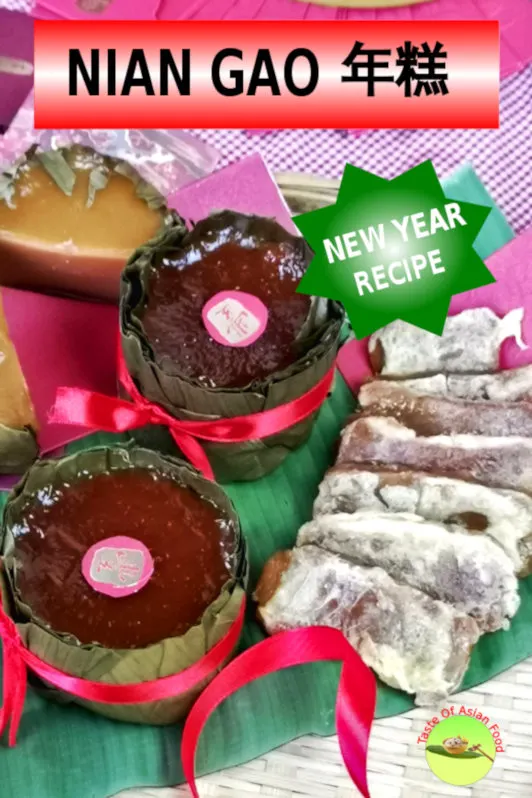Nian gao (also known as kuih bakul)- is the must-have delicacy for Chinese New Year. Why? Since the character nian gao in Chinese is 年糕 is the homonym of the other two words 年高 (nián gāo), which means ‘a prosperous new year’, nian gao is most appropriate to serve during this auspicious festival. It is also a popular gift during the spring festival to convey a good luck message.
However, making this popular dessert is tedious. The traditional method involves grinding the glutinous rice, removing the excess water from the rice paste, mixing with sugar, and subsequently going through a prolonged steaming process for up to 20 hours.
I guess most people will not attempt to make this delicacy at home unless they have plenty of spare time or intend to produce a large batch for sale.
Therefore in this article, I want to introduce a simplified version, which will only take about 2 hours of steaming. The ingredients required are incredibly simple. Glutinous rice flour and sugar are all you need. When I told my mother-in-law that I wanted to simplify the nian gao making process within 3 hours, her jaw drops and look at me in disbelief! But I think this is the way to keep this Chinese culture alive, as the younger generation may find that making it is too time-consuming.

Note: This post may contain affiliate links. Please read my privacy policy for more info. I may receive commissions for purchases made through links in this post. As an Amazon Associate, I earn from qualifying purchases.
Here is the step-by-step instruction on preparing the nian gao, also known as sticky rice cake, in English.
Step 1 Wrap the mold with banana leaves
Here are the steps
- Cut the banana leaves into sections.
- Clean the leaves under running water. Pat dry.
- Blanch the banana leaf in hot water to soften it. Alternatively, soften the banana leaves by heating it over a stove. Heat-treated banana leaves will become softer and will not easily break when it is used to wrap around the small cake pan (the mold). I prefer to heat the banana leaves over the stove because it is quicker and simpler.
- Wrap the banana leaves around the outer rim of the mold and insert the remaining part of the leaves into the mold.
- Insert a smaller round container into the mold and press the leaves against the base and the inner wall of the mold.
- Repeat the same process by adding one or two more leaves.
- Then, cut a piece of round shaped leave with a diameter slightly bigger than the base. Insert and press against the bottom to cover the base completely.
- Secure the position of the leaf by putting a rubber band around the rim of the container.
Tips
- Get an appropriate mold for the nian gao. The ideal size should be a small cake pan about 8 to 10 cm ( 3 to 4 inches) in diameter.
- You can certainly purchase this type of mold from the store. However, if it is unavailable or does not wish to buy it merely because of making the nian gao once a year, you may make use of any empty metal cans. Clean the can, and you are ready to go. This method is used by most of the traditional nian gao producers in my hometown. Besides that, you can also use ramekins as the mold.
- It is vital to cover the inner surface completely to avoid the glutinous rice flour mixture from leaking out during steaming. Since glutinous rice flour is very sticky, it can be challenging to remove the nian gao from the container if it sticks onto the can.
- The use of multi-layers of leaves does not only prevent the rice flour mixture from leaking, but also infuse the banana leaves aroma and flavor to the nian gao. I suggest you use at least two layers of banana leaves to ensure that there would be no leakage
- If you do not have banana leaves, you can line the mold with non-stick baking paper or parchment paper. However, nian gao will lack the natural aroma of the banana leaves.
Step 2 Caramelized the sugar for better flavor
Here are the steps
- Heat the granulated sugar in a pot over low heat.
- Keep stirring until most of the sugar has melted and turned into golden brown. The time required is shorter if you start with brown sugar.
- Add the hot water or the pandan extract bit by bit into the caramelized sugar. Be careful not to add too much initially as the sugar will react with the water and boil rapidly.
- Once you have finished adding the water, stir and keep aside. Any remaining sugar will dissolve by itself after it cools down.
Tips
- Do NOT caramelize to sugar until dark brown, as it will make the nian gao taste bitter.
- Be careful when you add the water or pandan extract to the syrup initially, as the volume will expand rapidly. Make sure the pot is big enough to prevent it from spilling over the edge.
- You may use less sugar for a less sweet version. However, since sugar is a natural preservative, the nian gao made with less sugar content will get moldy faster than those that are sweeter. Therefore it is advisable to store the nian gao with less sugar in the refrigerator.
- You may wonder why it takes such a long time to steam the nian gao traditionally. Then is because the sugar is not caramelized before adding to the glutinous rice. Instead, the sugar will be caramelized slowly during prolonged steaming.
- You can enhance the flavor by substituting part of the sugar with palm sugar, and add some pandan extract to the sugar mixture while caramelizing the sugar. Some people also replace part of the water with coconut milk in the recipe.
- To prepare the pandan extract. cut a few pandan leaves into short sections and let it steep in hot water for 10 minutes. Pour through a wire mesh strainer to remove the leaves.
Step 3 Constitute the glutinous rice flour mixture
Here are the steps
- Measure the required amount of glutinous rice flour in a large container.
- Add the caramelized sugar syrup into the glutinous rice flour slowly.
- Combine the syrup and the rice flour into a smooth batter with a fork or a handheld mixer.
- Let it passes through a wire mesh strainer to remove any possible lumps.
Tips
- Make sure you are using glutinous rice flour, not regular rice flour. If you prefer a less sticky texture, you can replace a quarter of the glutinous rice flour with ordinary rice flour. Rice flour is available in most Asian markets and grocery stores.
- Those vendors who sell nian gao in large amount prepare the glutinous rice flour from scratch. They mill the glutinous rice with some water, then remove as much water as possible, add sugar and mix until the sugar starts to melt and form and lumpy mass. In our home setting, it is more convenient to replicate by using glutinous rice flour.

Step 4 Steam the nian gao
Here are the steps
- Pour the mixture into the mold line with the banana leaves.
- Cover the molds with aluminum foil.
- Set up a steaming station. Steam the nian gao over medium heat with the lid on for 30 minutes. You can use a bamboo steamer if you have one.
- Reduce the heat slightly and continue steaming over medium heat for another 1 1/2 hours.
- After 2 hours of steaming, remove the nian gao and let it cool at room temperature.
- To unmold the nian gao, fold the leaves upwards, then pull the nian gao out from the mold.
- Cut off the excess leaves on top of nian gao, and there you go, your nian gao is ready.
Tips
- Since it takes two hours to steam the nian gao, check the level of water in the pot from time to time to ensure there is enough water for steaming at all times.
- The color will slightly darken when it returns to room temperature.
To serve
This Chinese New Year cake can be served on its own. However, a better way is to cut it into slices, coat it with egg, and pan-fry until golden brown.
Freshly made nian gao is very soft. It is easier to cut into slices after refrigeration for two days, as it will become firmer after refrigeration.
The traditional way of making nian gao takes about 20 hours of steaming until all the water content is gone. Therefore, it can be stored for a very long time without the need to be refrigerated. The modern way of making it takes much less time and, therefore, needs to be refrigerated as it can get moldy quickly at room temperature.
I hope you will enjoy making this sweet rice cake since this method is less time-consuming than the traditional way. Also, if you are preparing to celebrate the lunar New Year celebration, check out the turnip cake and pineapple Tart recipe that I posted recently. There is also a vegetarian dish called Buddha’s delight, which my family prepares yearly and serves on the first day of the Chinese New Year.
Happy Chinese New Year. 新年快乐,万事如意.

Nian Gao
This recipe is a quick and easy way to make nian gao (年糕). It only takes half a day to make it, as compared to 20 hours of prolonged steaming according to the traditional method.
Ingredients
- 350g glutinous rice flour (2.2 cups)
- 350g white sugar (1.7 cjups)
- 350 ml of water (1.4 cups)
- 20g pandan leaves (about 4 leaves)
- Banana leaves to wrap the mold
Instructions
- Clean the banana leaves.
- Soften the banana leaves by heating it over a stove.
- Wrap the mold with banana leaves (double layer) around the outer rim.
- Repeat the same process by adding one or two more leaves.
- Then, cut a piece of round-shaped leaves to line the base of the mold.
- Heat the granulated sugar in a pan over low heat until caramelized.
- Add all water to form a diluted syrup.
- Add the caramelized sugar syrup into the glutinous rice flour slowly.
- Combine the syrup and the rice flour into a smooth batter.
- Let it passes through a wire mesh strainer.
- Pour the nian gao mixture into the molds and cover with aluminum foil.
- Steam for two hours.
- To unmold the nian gao, fold the leaves upwards, then pull the nian gao out from the mold.
- Cut off the excess leaves on top of nian gao.
Recommended Products
As an Amazon Associate and member of other affiliate programs, I earn from qualifying purchases.
Nutrition Information:
Yield: 2 Serving Size: 3 nian gaoAmount Per Serving: Calories: 1244Total Fat: 4gSaturated Fat: 1gTrans Fat: 0gUnsaturated Fat: 2gCholesterol: 0mgSodium: 191mgCarbohydrates: 293gFiber: 6gSugar: 182gProtein: 14g
This data was provided and calculated by Nutritionix on 12/21/2019



Chinese New Year recipes - 10 auspicious food that brings you prosperity
Thursday 9th of January 2025
[…] Click here to get the Nian Gao recipe […]
Cheryl
Sunday 15th of January 2023
Where do I get pandan leaves? Can u translate the cups etc?
KP Kwan
Monday 16th of January 2023
It is not commonly available in some countries outside Asia. However, I know that you can get it from Amazon. I found a link for you: https://amzn.to/3qRCCsv
You can use this free service to convert the measurements: https://www.convert-me.com/en/convert/cooking/
Anyway, I have updated it in the recipe
Joanna
Saturday 14th of January 2023
Hi KP, is it possible for you to post a recipe on frying nian gao (the one with sweet potato)? Thanks.
KP Kwan
Monday 16th of January 2023
Thanks for the recipe suggestion. I will keep it in mind for future recipe development. Meanwhile, there is little time for me to do it this round of Chinese New Year. Cheers!
Lucia
Thursday 11th of February 2021
Is the ratio 1:1:1, so can I reduced the amt and make in a 7 in pan? Thank you
KP Kwan
Friday 12th of February 2021
The mold I use is four inches in diameter, and the recipe is for three nian gao. You need to make the adjustment to suit your mold.
Michael Loh
Thursday 5th of March 2020
Hi KP, Just 1 question. Do you mix the caramel syrup with the flour whilst it's hot, or do you cool it first.
KP Kwan
Friday 6th of March 2020
Hi Michael, I let the syrup cool down first before adding it to the flour. It does not need to be completely cold, but as long as it is not so hot that you can't handle it. I hope this is useful. KP Kwan